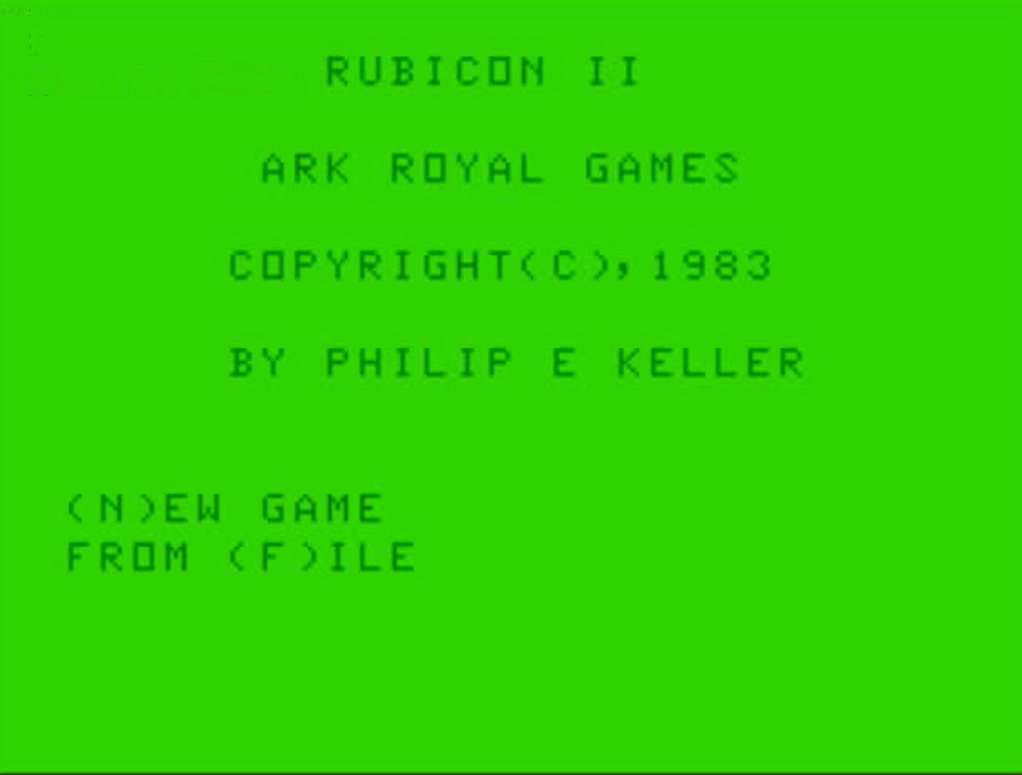
“I want to make a WW2 game about crossing the most iconic river of Western Europe: the Rhine.”
“I am afraid the most iconic river of Western Europe is the Rubicon.”
“Whatever, as long as the Americans cross it straight into Germany!”
Across the Rubicon is the first game by Ark Royal Games, the most prolific computer wargame developer you have never heard of, even though it rivals if not exceeds SSI in terms of number of wargames released starting in 1984. The reason you never heard about them: every single one of their wargames was exclusively for the TRS-80 “Coco” Color Computer.
According to L. Curtis Boyle, Ark Royal Games started when its founder Philip Keller critically failed in his attempt to throw a die in a tabletop wargame:
In the fall of 1981 I was playing Wooden Ships & Iron Men (Avalon Hill) with a friend of mine and I dropped the die. I bent to pick it up, knocked over the combat results table chart, which in turn knocked playing pieces off the map. In my knee-jerk recovery, I sent the box and zillions of charts, tables, graphs and cardboard squares flying. There has to be a better way, I thought, and there was. The following spring I invested in a Color Computer and went looking for wargame software. There wasn't any. Forced to write my own. But first I had to learn to program. Thank heavens I bought from Radio Shack! Their manuals are excellent. Something called SQUAD was written. Terrible, but it was a start. From there it was the 16K Across The Rubicon.
Squad was never released, but Across the Rubicon was announced through an ad in the October 1982 issue of Rainbow, the Color Computer magazine. As I will explain later, there were two versions of the game, and I am going to play the later 1983 32K version.
The manual states that Across the Rubicon is, surprisingly given the name, about “the battle for the Huertgen Forest during WWII”, the last decisive American defeat on the Western Front. The good news is that I don’t need to write a paragraph about this battle, because the scenario does not look like the battle for the Huertgen Forest at all but rather about some non-specific 1945 “crossing the Rhine” action.
The game starts by giving you 1200 resource points to allocate between different units:
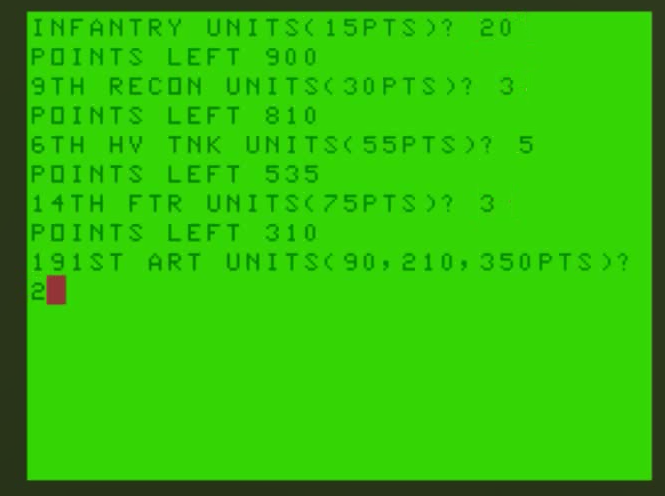
- Infantry (cost: 15 points) is the basic unit of the game – the player must buy at least 15 of them. Their starting “strength” is a random value between 13 and 17, and all units created with 15 strength points or more also carry a mortar, in game terms a weak short-range weapon that can whittle down enemy units without risks,
- Recon Units (30 points) are exactly as strong as infantry (15 strength points), but twice as fast (4 movement points instead of 2),
- Heavy tanks (55 points) are expensive, but relatively fast (3 movement points) and powerful (25 strength),
- Finally, both Artillery and Tactical Air are off-map support assets. Artillery is powerful but expensive (90 points for one artillery, 210 for two, 350 for 3) and can only shoot rarely, air is less expensive (75 points) and more flexible, but less powerful.
The final composition of my army is the following:
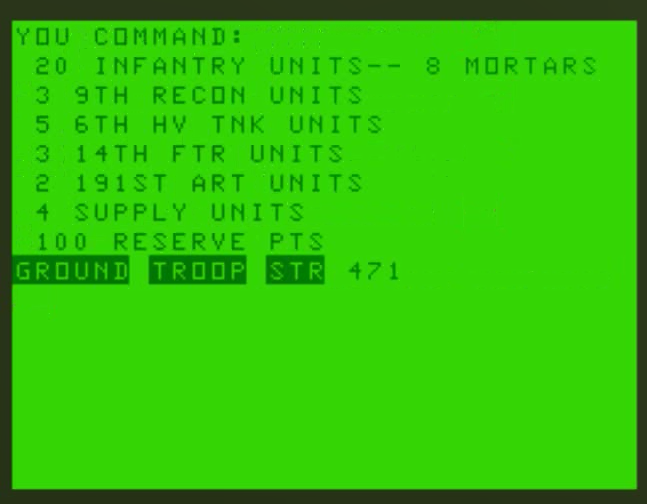
The units are then automatically deployed in front of the nondescript river that is unlikely to be the Rubicon.
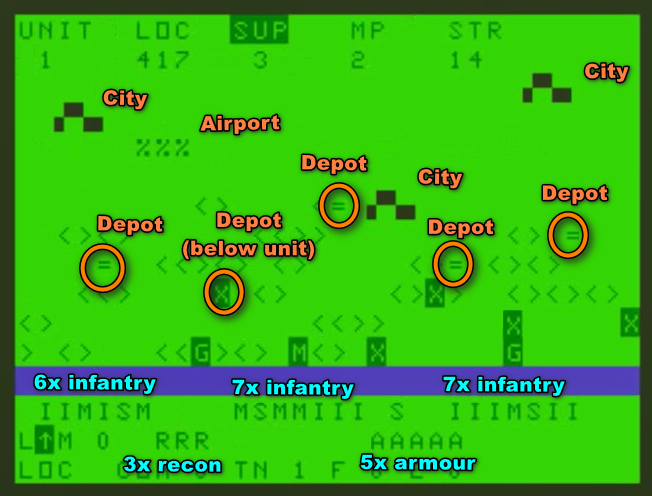
The objective of the game is to capture the airport, the three cities and 3 of the 5 depots in fewer than 20 turns. The Germans have a strong defensive position:
- First, I need to cross the river, which blocks my movement,
- The “<>” represents rough terrain that favours the Germans,
- The German [P]anzers (none detected at the moment) have a bonus compared to my units,
- Finally, the game has a nice “design-for-effect” rule: in combat, units that are above the others on the screen have a combat bonus,
My strategy is to avoid the centre of the map and attack through the sides: the Western one looks less defended, while the right one has less rough terrain. I will push deep, and fall if needed on the central city from the left and right rather than from the bottom of the map.
Every turn, I am allowed to send one patrol from an infantry unit, which can scout up to 5 tiles away. I use it to check my prospective landing site on the left, finding nothing. I can cross safely, it seems.
On the right, I want to destroy the forces waiting for me on the other side, and I have two possible tools to do that:
- Artillery is powerful, but once an artillery fire it takes 1 to 4 turns before I can use it again. Still, I will start with that,
- Air attacks are more accurate (they can only hit 6 tiles instead of 9), but less powerful. I can use as many as I want in any given turn, but at some point, I will run all out and no more air missions will be available for the rest of the game, so for now I will use them only to finish off the enemy,
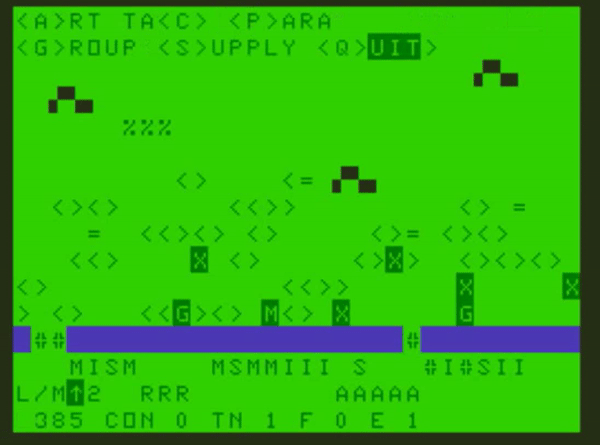
After two artillery strikes and one air attack, the opposition is removed. My hastatii vanguard can cross! It takes me several turns to cross with everyone, due in parts to German counter-attacks on the crossing spots :
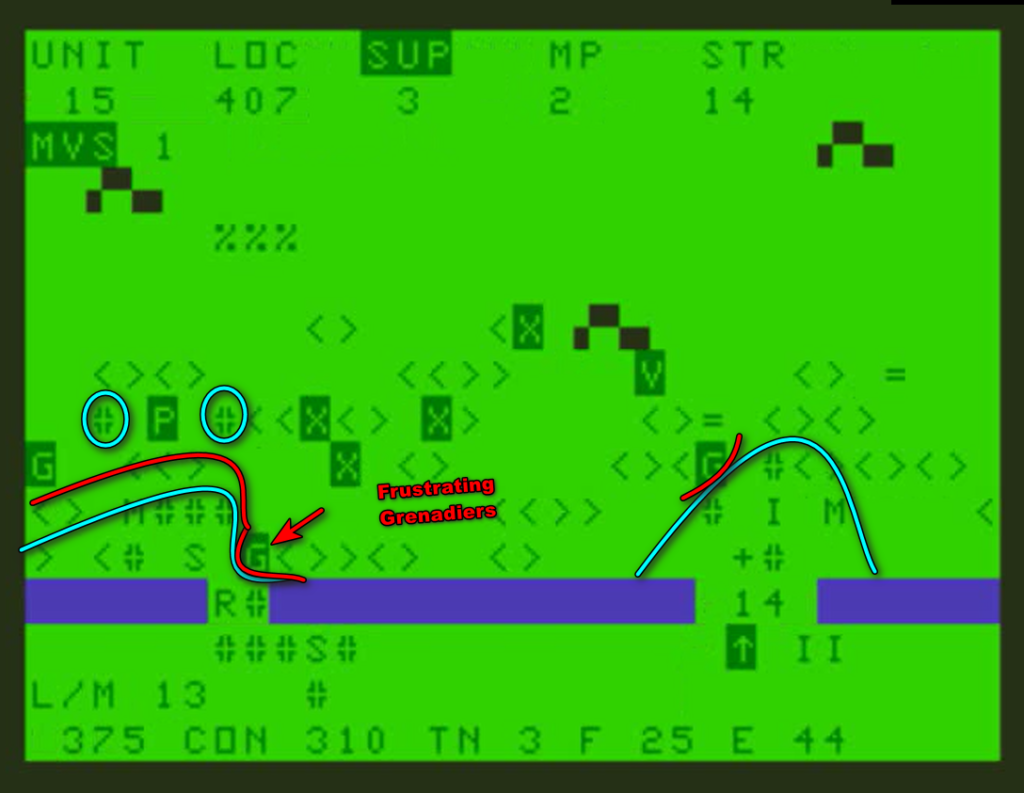
At this point, the battle is turning bloody. I had to break through well-entrenched Germans left and right, and got counter-attacked again, which forced me to counter-counter attack, because well, I really need to expand my breakthrough. Losses doubled in one turn :
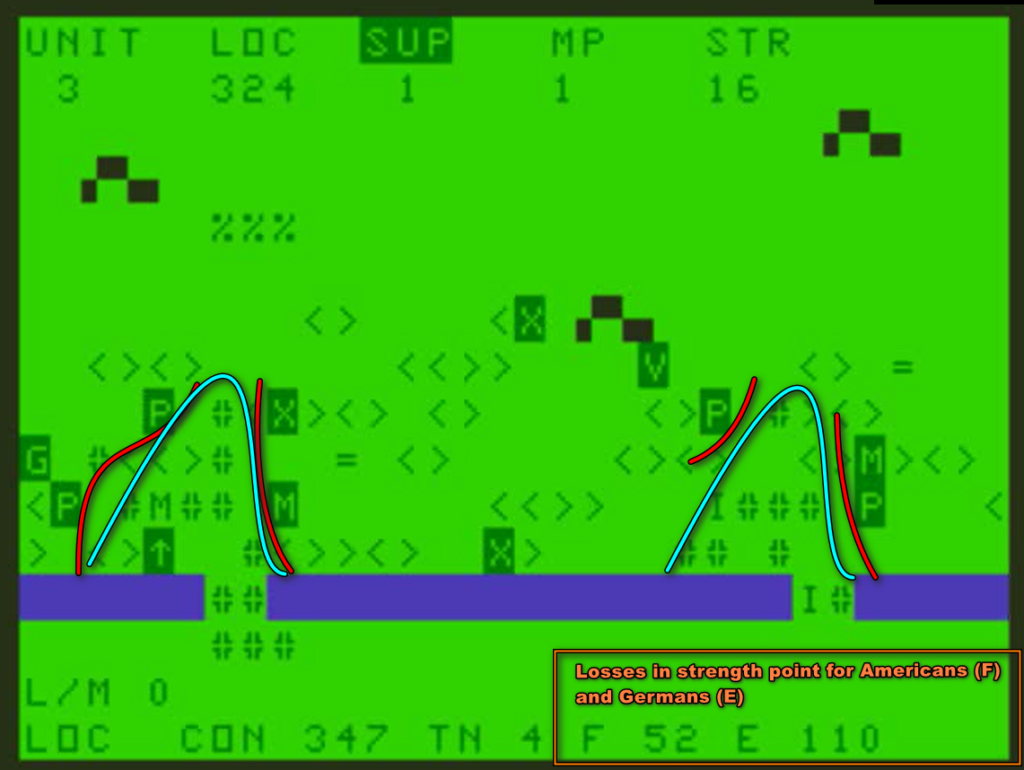
By the end of turn 5, I had pretty much fully crossed and started to reach clear terrain on the right – perfect for my tanks:
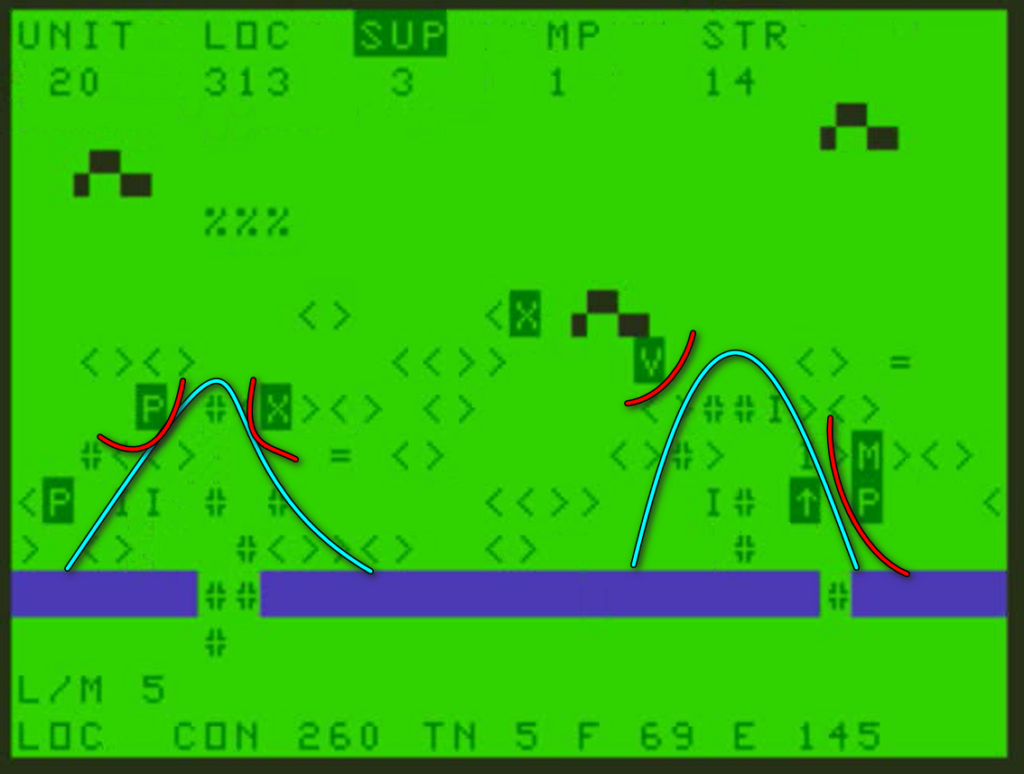
In truth, it is pretty hard to convey in an AAR how intense the combats can be:
- Units can stack, so what looks like an isolated unit can be tanks and soldiers and more tanks on top of each other,
- When enemy units are in contact, the loser of the battle is pushed back so it looks like no one is ever in contact on any given screenshot.
But here is a typical example of what happens :
- My infantry advances and discovers a hidden Panzer unit. It is pushed back with 3 strength losses. I immediately order air attacks to soften the enemy up (only showing the first one on the GIF below),
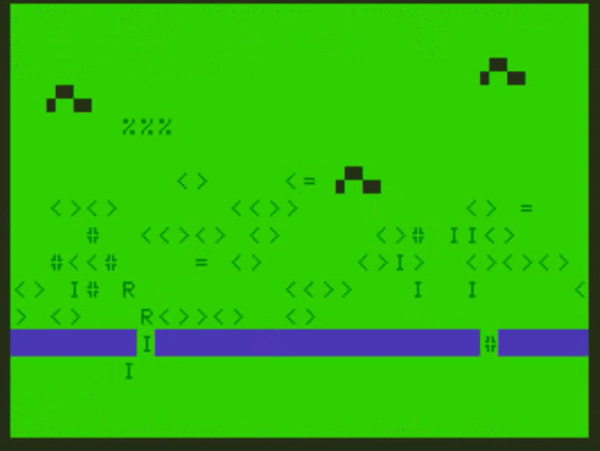
- After the air attack, I send my fast recon units to attack from the side, the first one is repulsed, the second one destroys the enemy panzer, but occupying its tile it finds another (Grenadier) unit and it has to fall back after all.
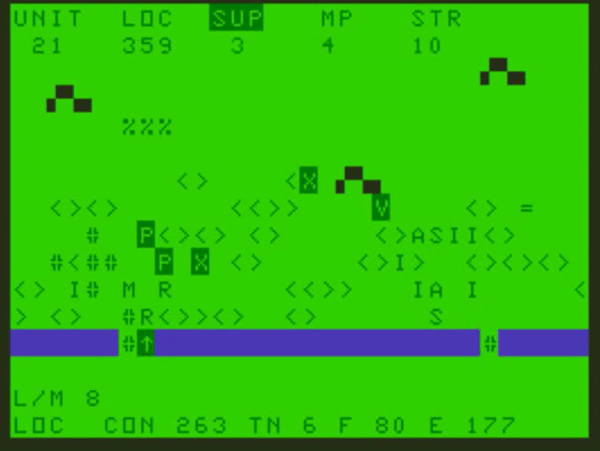
Anyway, after a lot of this, I was turn 7 in a solid position, and had broken through in the West.
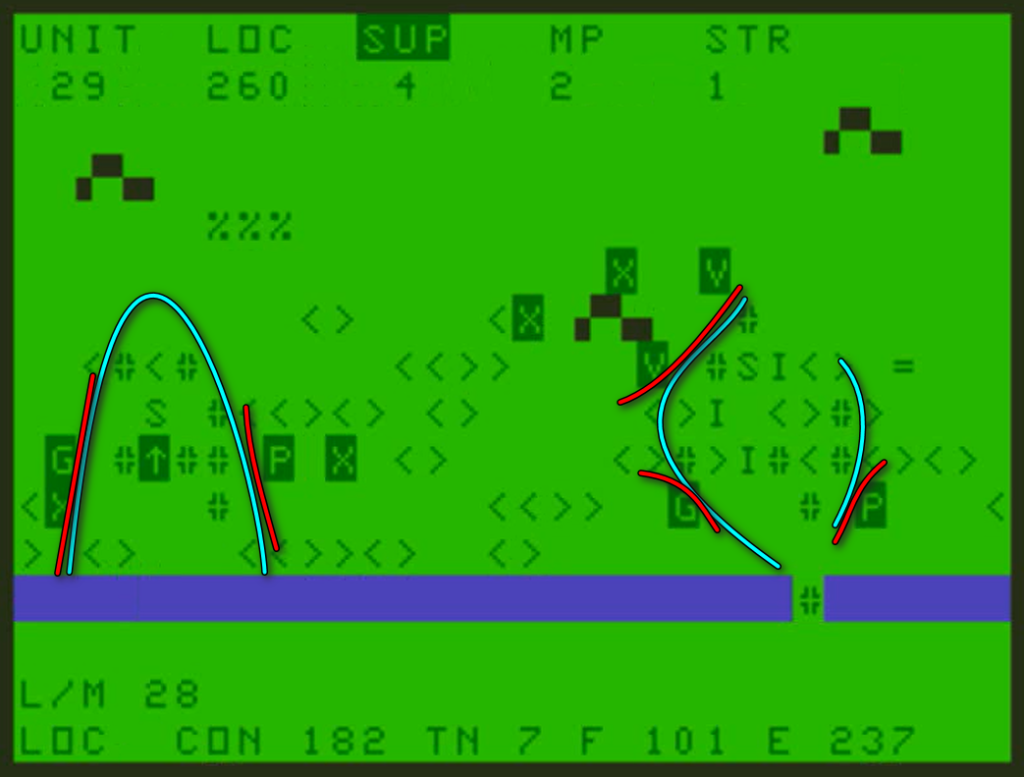
The reason I could not exploit my advance as much as I wanted was that my supply units were still lagging behind. Units can survive 3 turns out of range of your supply units, after which they stop moving and lose strength points every turn :
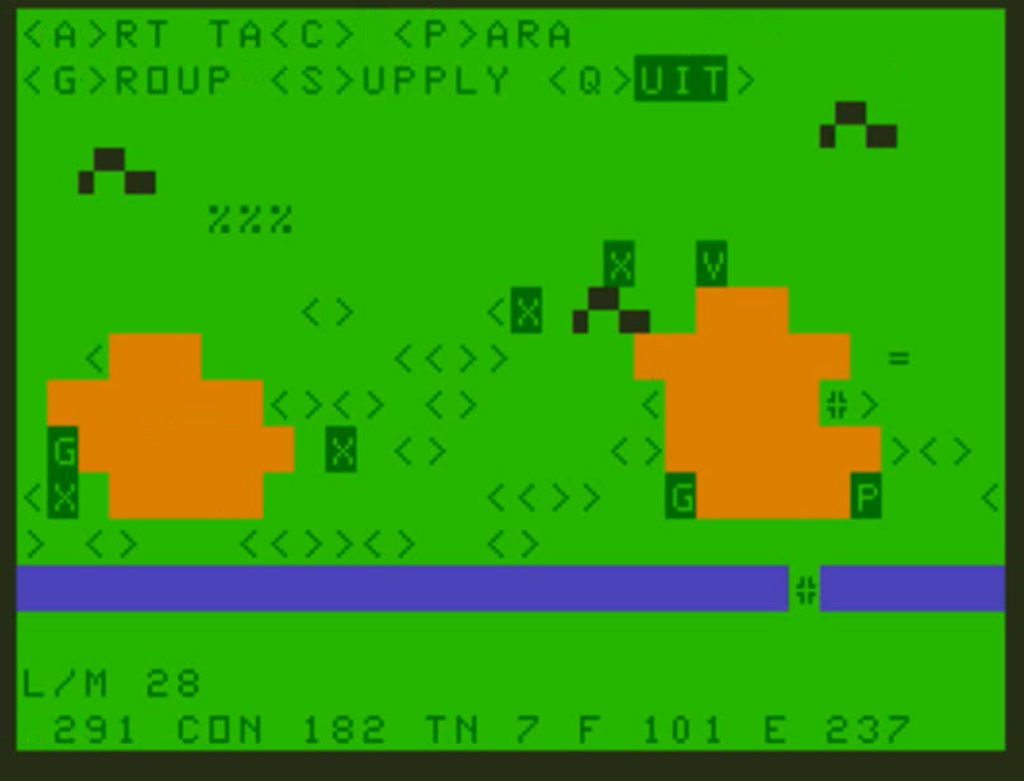
I had also received some significant damage (101 strength points in total lost as per the screen above), so it was time to use one of the many options offered by the game between turns :

First, I merged two of my recon units that had been badly damaged. You can merge units when they are on the same tile and their combined strength is less than 15 :
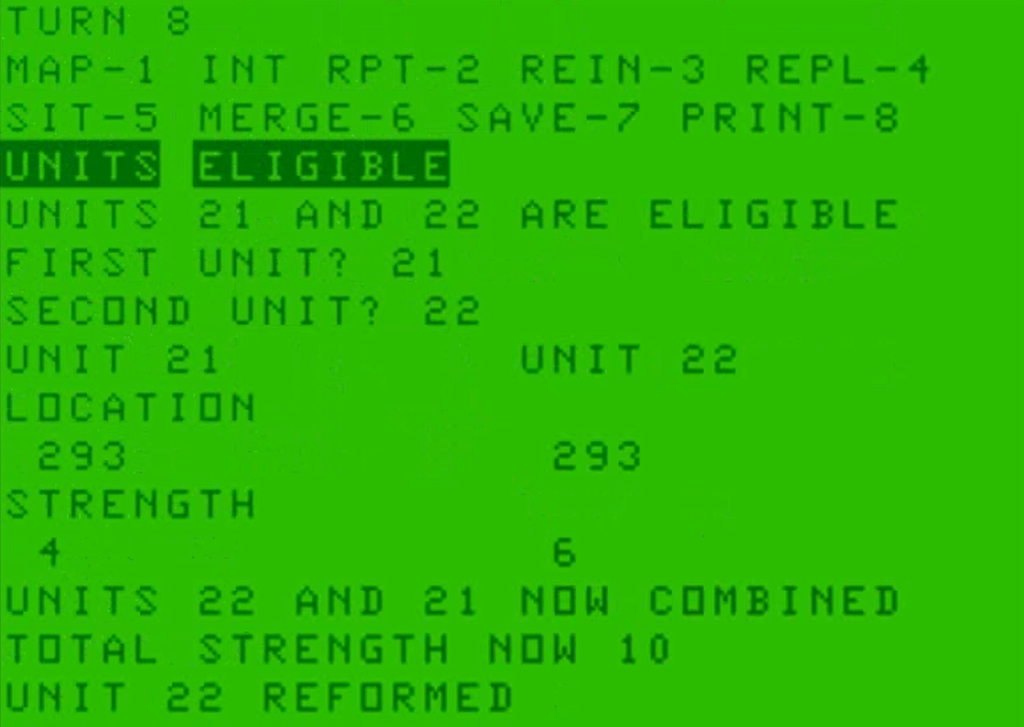
I could also bring some replacements, basically a tiny percentage of the total losses is reallocated to one or several units randomly, or at least according to rules I don’t understand:

The game allows you to check the status of your whole army, just like in Bomb Alley, but without the cool Italian names – because again I am not playing the Romans.
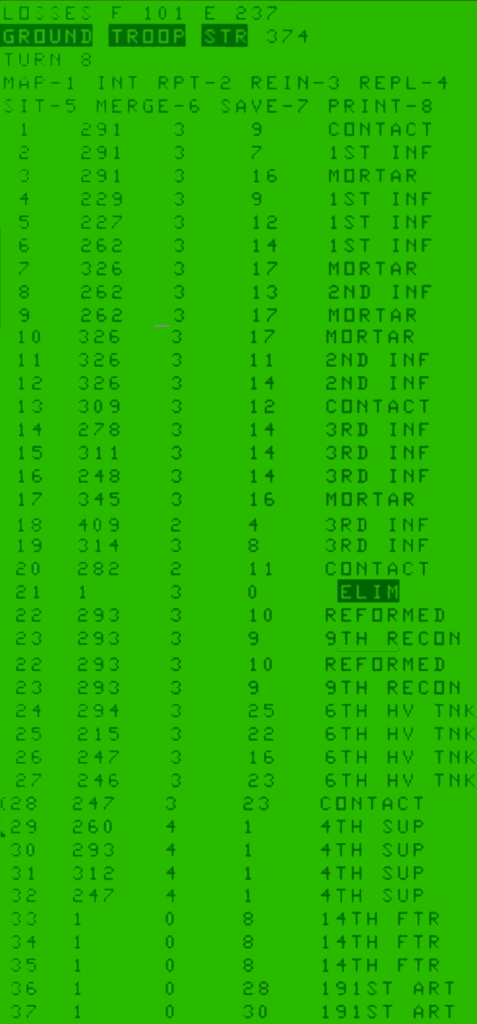
Finally, I can “reinforce” by buying back eliminated infantry units, which then appear on the wrong side of the river and away from my supply units, but then I can just spend some extra points to paradrop the fresh unit of terrified conscripts in the thick of the action! Some will die in the jump but hey, that’s a sacrifice I am willing to take.
In any case, I have shown most of the features of the game, so I can go very quickly now :
- By the beginning of turn 10, I am pushing my (A)rmoured fist deep into enemy territory in the East, while in the West my progress is slow as my mostly infantry force has to go through more difficult terrain.
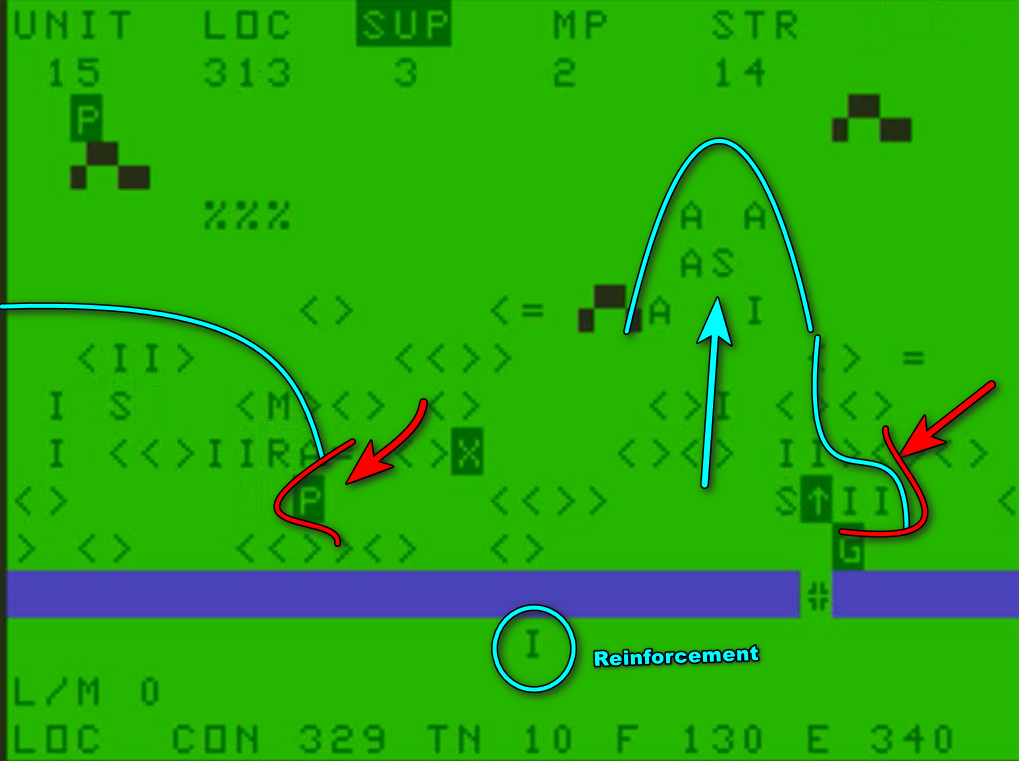
- By the beginning of turn 12, I can move toward the city and airport in the West, while my tanks raid the central city by the top of the map, so with a combat bonus.
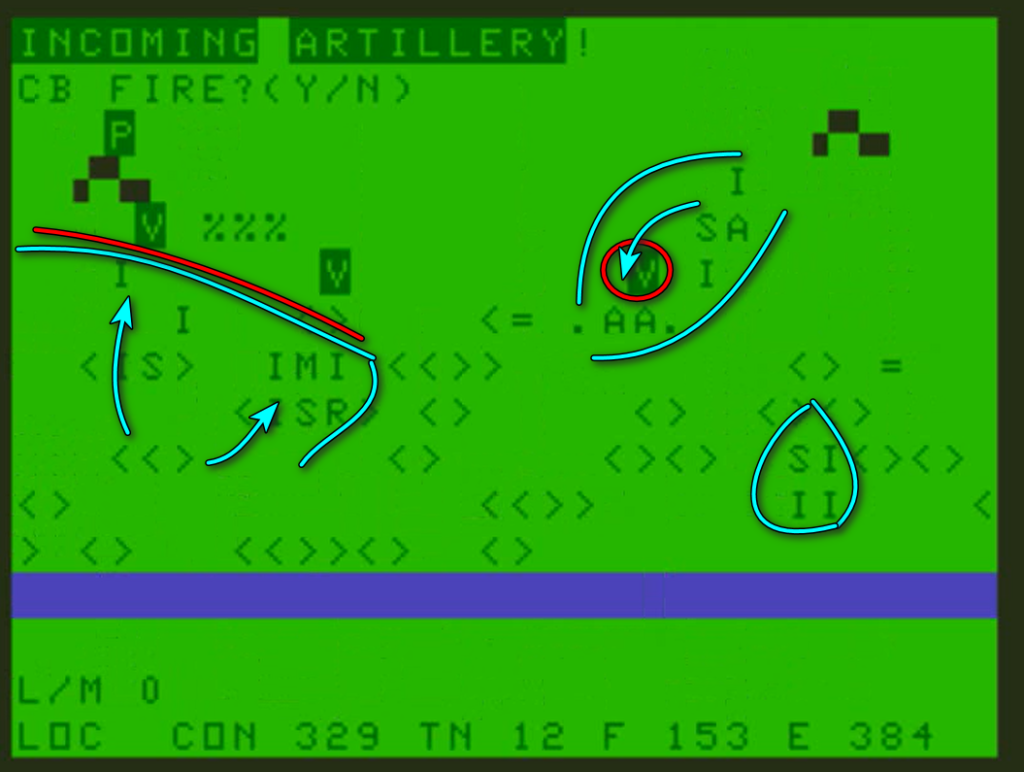
- Turn 14, I realize the top-left corner of the map is very well-defended, a discovery that cost me a lot of strength points in probing attacks. I am all out of air support, so it is going to be gruesome. Meanwhile, I am concentrating for the final assault on the poorly defended top-right city.
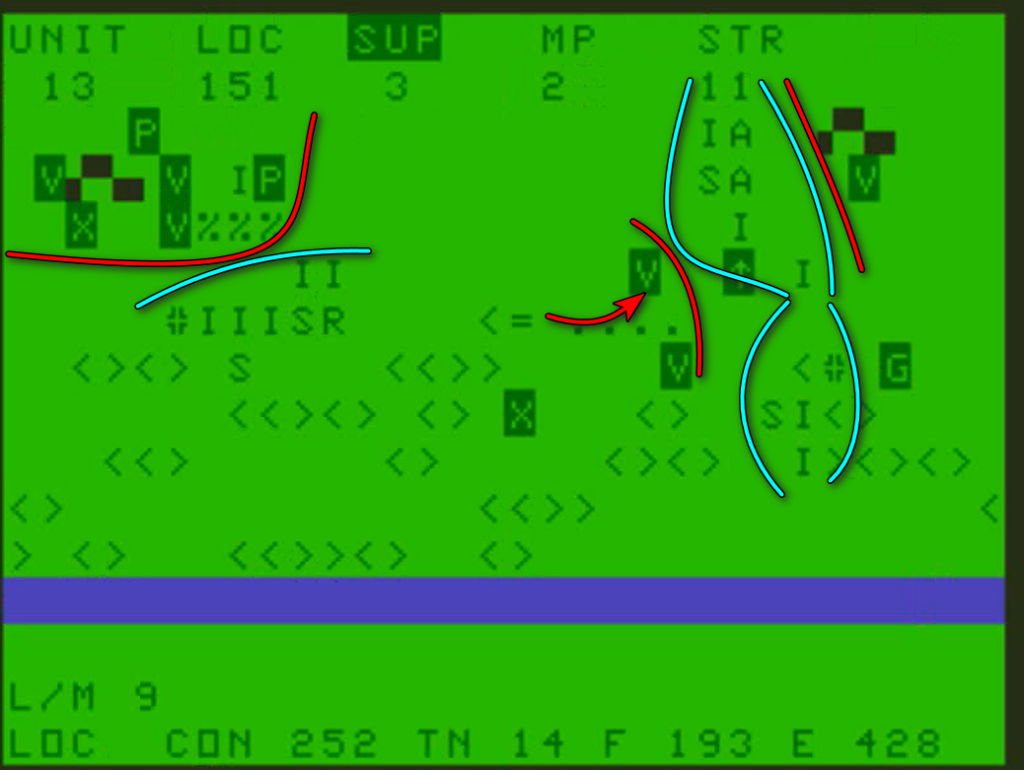
- Turn 16, I try to flank the airport to avoid the “attack from the bottom of the map” penalties – more costly battle there, though I keep bringing paratroopers as reinforcement. The Easternmost city is all but taken.
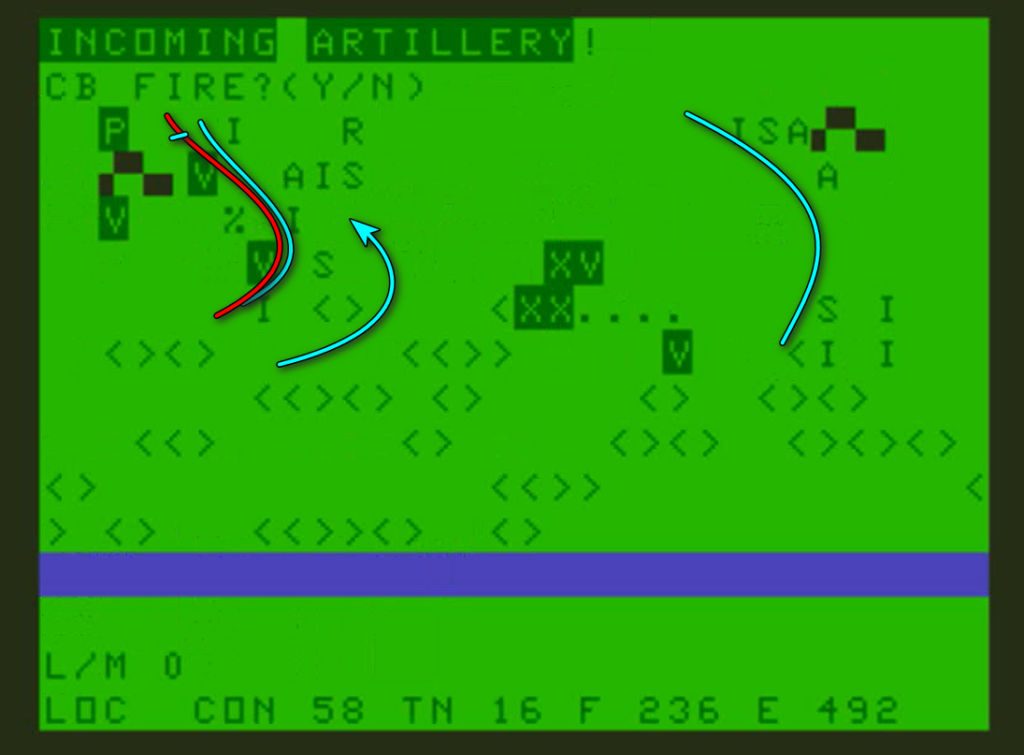
- Turn 18, I take the airport and advance toward the last city, but with catastrophic losses (65 strength points in 2 turns, so 25% of what I had lost so far !). I am out of replacements, I am on my last leg…
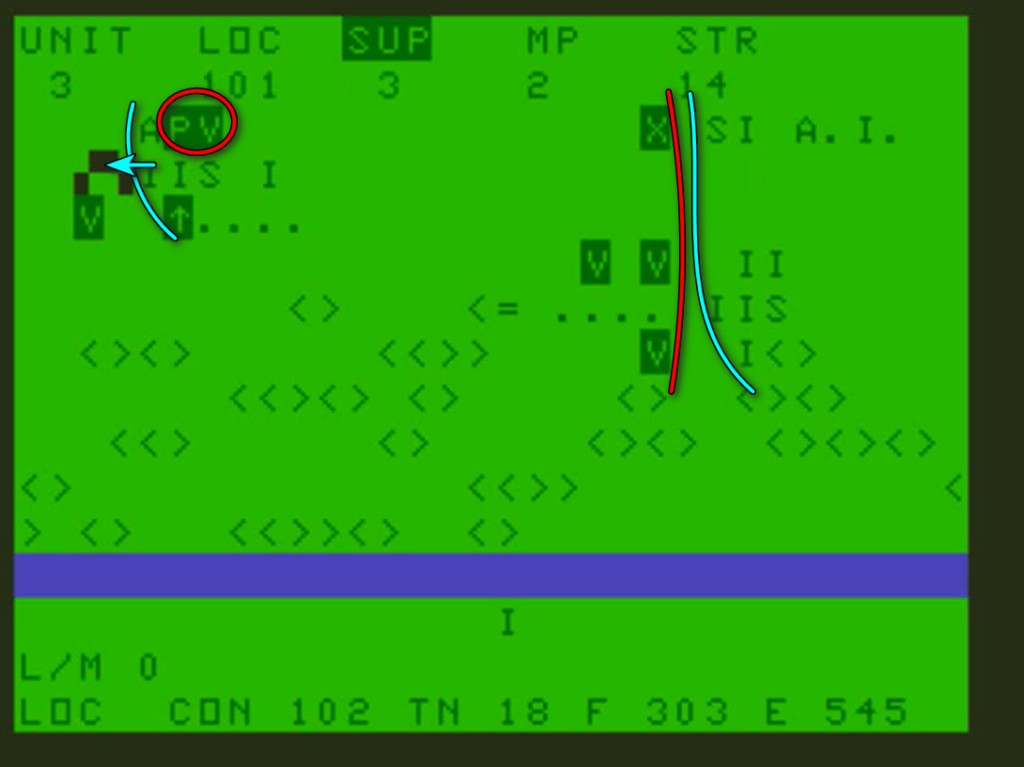
… but it turns out that the defenders were depleted as well, and I only had to push a unit in the city to end the game!
Victory!
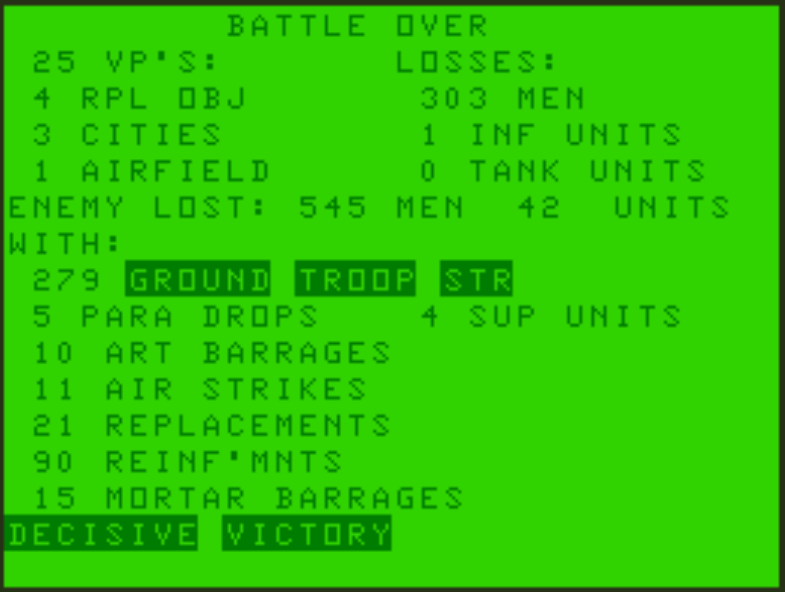
It was a surprisingly good experience, though probably not the best material for an AAR. I am happy to have won the game on my first (real) attempt.
I would like to thank the DataDriven Gamer for teaching me how to use the MAME emulator, and L. Curtis Boyle for telling me how to run this game specifically.
Rating & Review
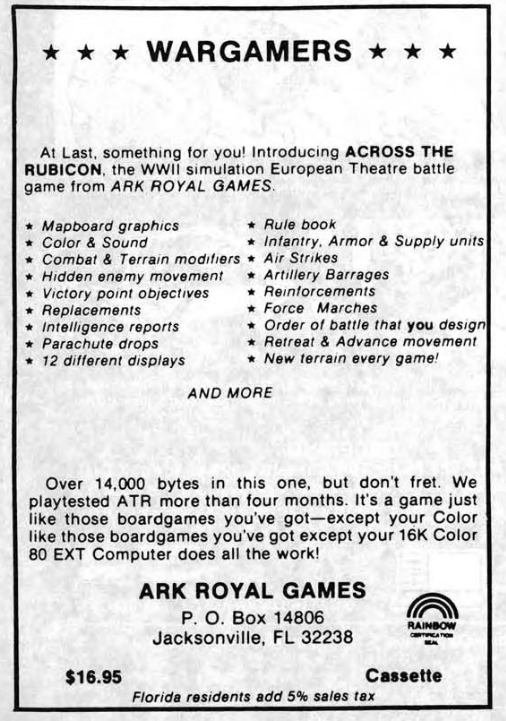
Across the Rubicon and Rubicon II by Philip Keller and Ark Royal Games
First release :
October 1982 on Tandy Color Computer (Across the Rubicon 16K)
July 1983 on Tandy Color Computer (Across the Rubicon 32K, aka Rubicon II)
Tested on : Tandy Color Computer emulator (MAME)
Total time tested : 3 hours
Average duration of a campaign: 2 hours
Complexity: Average (2/5)
Final Rating: Obsolete
There is very little documentation available on Across the Rubicon, or on Ark Royal Games in general. Their games were rarely reviewed andnever attracted the kind of attention SSI or Epyx received, and generally speaking the Tandy Computer owners seem to have lived in a different universe than the Atari or Apple II owners, with less ambition and fewer heroes. There are also fewer hobbyists and historians of the Color Computer today than of the Atari, the Apple II or even the TRS-80 “uncolored”.
From what I can piece-up from the ads and the manual, Across the Rubicon was initially a 16K game released in October 1982. In July 1983, Ark Royal Games announced the 32K Rubicon II, which had “everything ATR has and more !” Finally, in December 1983, Rubicon II was rebranded as Across the Rubicon 32K.
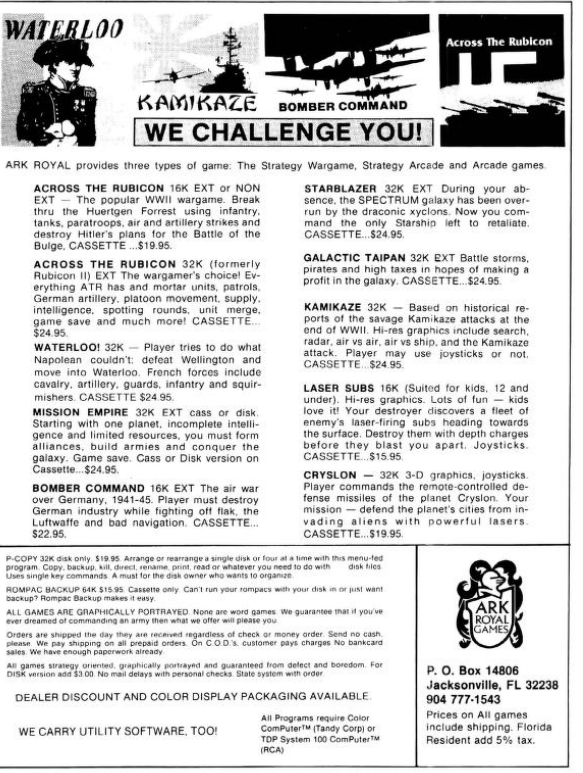
There are a lot of differences between the two Across the Rubicon, but none that change the nature of the first game. The most significant changes are the controls – I daresay that the 16K version was nigh unplayable.
A. Immersion
Not a lot of effort there. “The ruleset feels WW2″ is the nicest thing I can say.
Rating: Terrible
B. UI , Clarity of rules and outcomes
The UI of Across the Rubicon 32K is actually pretty solid given the constraints of the Coco. You can easily move the pointer from one unit to another and check the status / health of any of your units, targeting off-map support requires you to type the coordinate of your target but you can change it easily if you are wrong, and at any moment you are only two keys away from being able to visually check which unit is supplied and which one is not. In a nutshell, Across the Rubicon 32K does what SSI’s Tigers in the Snow failed to do.
But Across the Rubicon 32K is a 1983 game. The original Across the Rubicon was a UI disaster :
- You had to use support assets in the “interturn” menu, without a view of the map, and with only one chance to get the coordinates right,

- Instead of freely navigating from unit to unit with a pointer, you had to type the ID of the unit, and then move it. After you had moved it, you had to confirm you did not want to end the turn in an intermediary menu, and type the ID of the next unit. Of course, you had no way to check which unit was where, except by calling a list which gave you the coordinates of the unit (eg “unit 28 LOC : 421”).
- Finally, just to make sure you never finished a game, the 16K version did not have a “save” feature.
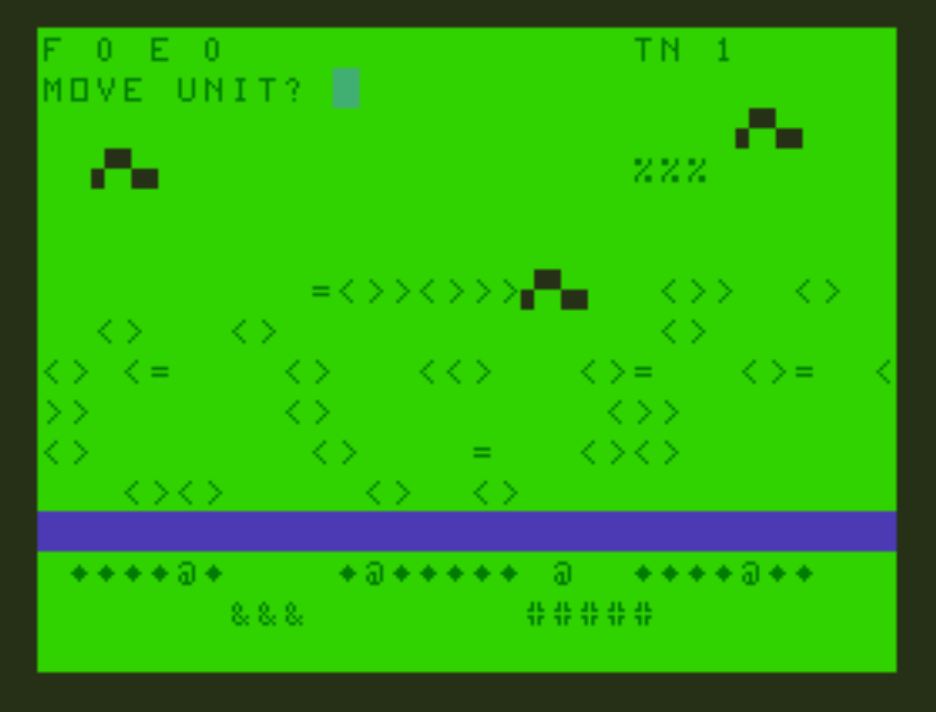
- Finally, there was no clear display of which area was under supply – you had to eyeball it.
Still, Across the Rubicon 32K is not perfect in this category. While the controls are easy, the rules for combat are poorly explained in the manual – I still don’t know if strength points have an impact on combat or whether they are only “HP”. You don’t see the enemy moving, and the only way to know whether you lost a unit during the enemy turn is to realize you have one unit missing. Finally, once a unit has moved, you cannot recheck it during the same turn, so you better remember whether it was almost depleted or healthy.
Final note: the unit movement is controlled with arrows, which given the layout of the TRS-80 keyboards must have been a bit less intuitive than we now expect :
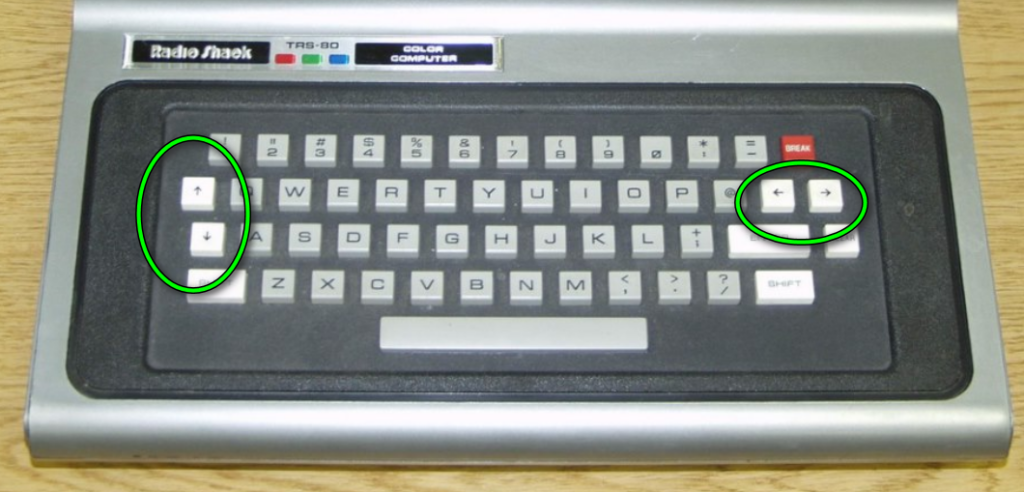
Rating: Acceptable (which is a feat given the nature of the game and the limitations of the Coco)
C. Systems
Most of the ruleset can be summed up as: “your units have movement points, you can move them horizontally and vertically; if they move to a tile adjacent to an enemy (including in diagonals), a battle may or may not ensue, and the loser will retreat. If the defender retreated the attacker has a free move in any direction“. There are indeed cases where your unit is adjacent to the enemy, but no combat is triggered, and I don’t know why.
The game then has a lot of well-integrated additional rules giving it a deeper layer :
- Offmap artillery support, but also (for the 32K version) on-map ranged support through mortars,
- Paratroopers! Everyone loves paratroopers!
- Detached patrols for reconnaissance (32K version only)
- Forced march at the cost of strength points, an option I did not use,
- Fragmented movement: you can move a unit a bit, then another, then finish the movement of the first,
- Merging of depleted units,
Across the Rubicon does not have any super-fancy rules, but it has more options than most of the contemporary competitors I have seen so far – it may be the first beer & pretzel game à la Panzer General I have played so far. I am not a fan of being forced to engage units when I move in contact with them, especially since the Germans don’t have that problem and can safely move next to you, but it still works.
Rating: Quite good
D. Scenario design & balancing
The game has only one scenario, with roughly fixed targets, but a random placement of the rough terrain. The real variation will come from the level of difficulty (1 to 5, I picked level 3) and from the army composition, but even then it is not much. The one scenario is pretty standard, no special rule of any sort, but at least the player does not feel funnelled like in Tigers in the Snow.
As much as I can judge, the AI seems very basic. Most of its moves are hidden, but I believe that its general strategy is quite simply to move toward you every turn, except for those units holding objectives. Once you have broken the core of the German units, you are only fighting Volkstrüm units spawning every turn, and whatever units defend the objective.
E. Did I make interesting decisions?
Yes, every turn. Most of these decisions were tactical, of course, but there were some long-term decisions as well: which objectives to prioritize, and when to allocate the limited air support resources.
F. Final rating
Obsolete. I expected the worst and ended up pleasantly surprised by the design of this game. Sadly, the solid design is pulled down by its lack of replayability, unclear rules and even more by the total absence of graphics or “chrome”. I am the first one to say graphics should not count, but watching the same ASCII screen with the same set of 5 units for two hours is going to turn away even the most committed wargamers when there are dozens of Panzer General clones to play. Still, I had two fun hours, and I am looking forward to checking out the rest of Ark Royal Games’ production.